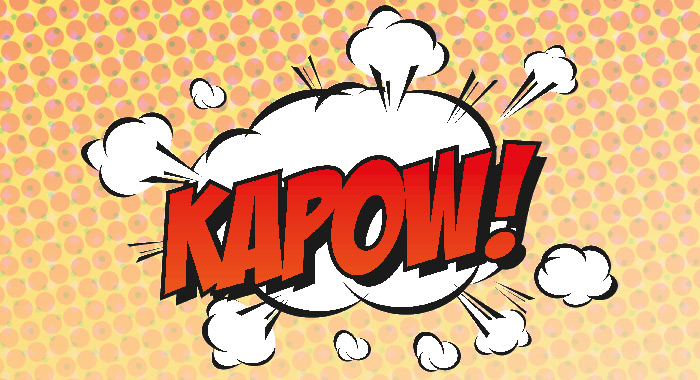Kapow!
It’s not often you hear college students squeal with delight. But then again, it’s not often the editor-in-chief of comics giant Marvel Entertainment – shazam! – pops in for a surprise chat. Marvel’s Axel Alonso did just that earlier this year, thrilling not only St. Norbert students, but staff and community members as well.
Alonso’s unexpected entrance was witnessed by about 200 people who had gathered on campus to hear the Skype talk “SkypeTacular! Ms. Marvel and the League of Marvel Women Speak,” the second of a three-part Skype series developed by the Cassandra Voss Center (CVC). The series highlighted several of the major scholars and creators of color in the comics industry, and was part of a broader CVC program, spanning the school year, studying gender, race, sexuality and class through the identity narratives found in the comics and superhero industry. Marvel Entertainment editor Sana Amanat was Skyping with the audience when Alonso suddenly joined her. The Skype chat by the dynamic duo marked Marvel’s first-ever college appearance.
“Some of the audience members literally gasped when we had the two on Skype,” says Anna Czarnik-Neimeyer ’11 (CVC). “But Marvel agreed to appear at St. Norbert specifically because we’re a college, and because we’re engaging with comics in a different way.”
What can college students learn by studying comics and superheroes with names like Spider-Man, Storm, Blade and the Hulk? Plenty, especially when considered through the prism of gender, race, sexuality and class. These issues are complex and can be intimidating to dissect with one’s peers and instructors. Discussing them through comics makes it a little easier, says Elizabeth Schmitt ’15, a CVC intern who assisted with the programming.
Lest you think comics have nothing to do with these topics, think again. The world of comics and superheroes is actually filled with an increasingly diverse array of characters, many of whom are being created specifically to show people of every gender, color and creed that they, too, are powerful. They, too, are special. They, too, can be a superhero. To wit: Ms. Marvel’s Kamala Khan, a Pakistani-American and Muslim superhero co-created by Amanat; the black Blade, a superhero and vampire hunter; and Dr. Light, a Japanese female superhero who’s an astronomer and divorced mother of two when she’s not using her powers to control and absorb light energy for the greater good. Holy light saber, Batman! – not a white male in sight.
The Marvel Skype chat, as innocuous as it may have seemed on the surface, really made a lot of people stop and think, says Schmitt. Including her. Amanat told the audience that, while growing up in New Jersey, she loved comics and devoured them, but was dismayed at never seeing a character in them who looked like her. When she landed at Marvel, creating such characters became one of her missions.
“That really stuck out to me,” recalls Schmitt, “because when I went to see movies like ‘The Fantastic Four’ or ‘Captain America,’ I never really thought about the fact that all but one of the main characters was a white man. And when you look at the women [in comics or superhero movies], they’re typically in bathing-suit-type costumes or cast as insignificant side characters. That sends a lot of messages about who’s powerful and privileged in society.” And who’s not.
The issue of societal portrayals in comics was such an intriguing topic, three St. Norbert professors decided to collaborate on an assignment for their students. Kelsy Burke (Sociology), Karlyn Crowley (Women’s & Gender Studies) and John Pennington (English) all had one of their classes create a six-panel (or more) comic strip with a storyline critiquing inequality as it relates to race, gender, sexuality and/or class. Adding to the fun, all of the assignments would be judged by Brad Ellis (Spanish), an avid comics consumer and collector since childhood. The winning comic would receive a piece of Marvel comics memorabilia. Tzamm!
Despite Ellis’ expertise, the task was challenging. Think about it – the students had to tackle serious, unfun issues such as gender inequality and racism, while incorporating comic and/or thought-provoking aspects. Oof! Plus, while Ellis is a lifelong comics consumer, he long ago made the decision not to analyze them academically. Now, he had to do so. Ellis came away a bit of a changed man.
“Comics for me have always been a way to relax and unwind,” he says. “They’ve been an alternative to the research I do in my teaching. But [judging the contest] gave me more of an awareness of the subtext and gender issues that are being played around with, especially in the newer comics.”
Why are rather revolutionary roles and serious issues being explored in comics today? Readership demographics are changing, says Czarnik- Neimeyer. Comics are no longer just a quirky piece of the nerd culture; an increasingly diverse slice of humanity is reading them. And those readers are clamoring for change. Pow! For inclusion. Zap! For recognition. Bam!
“Marvel made it clear,” says Czarnik-Neimeyer. “If companies receive feedback that consumers really want something, they’ll likely produce it. And that’s a major takeaway for students: If there’s something missing or wrong with how people are represented,then advocate for it to be better.” We are the future, Charles.
For now, things seem to be headed in the right direction. Comic books are being created that represent all of us, penned by talented writers who are crafting increasingly sophisticated material. “You can read them on different levels, much like we read great literary works,” says Ellis. And if this trend continues, then over time our collective consciousness will know everyone is strong. Everyone is powerful. Everyone is equal.
April 17, 2015












